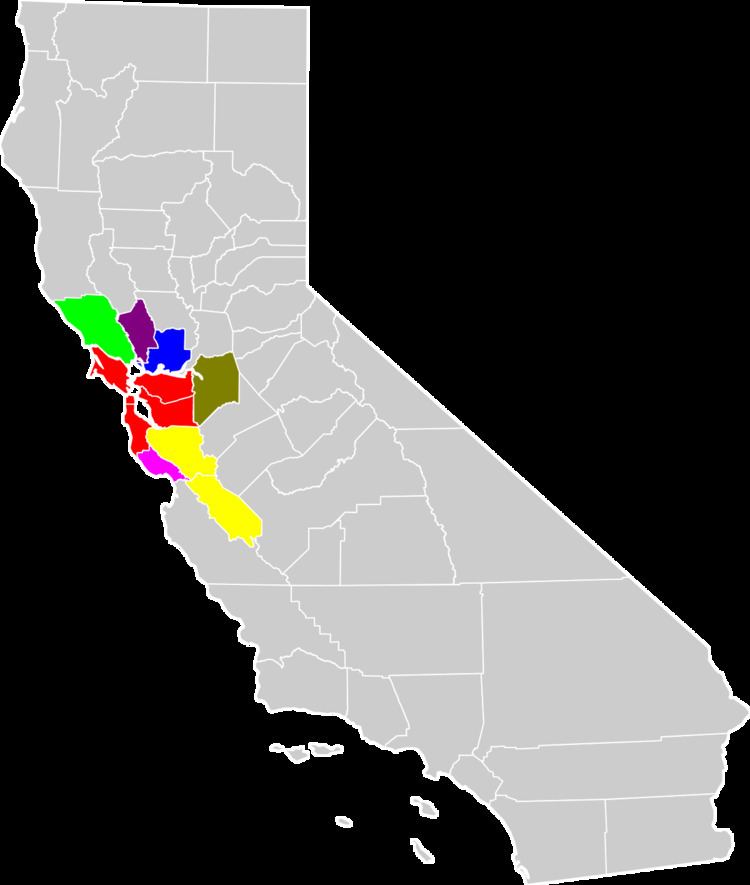 | ||
The San Jose-San Francisco-Oakland, CA Combined Statistical Area is a 12-county Combined Statistical Area (CSA) designated by the United States Office of Management and Budget in Northern California that includes the San Francisco Bay Area. The CSA is more extensive than the popular local definition of the Bay Area, which consists of only the nine counties bordering San Francisco and San Pablo Bays: Alameda, Contra Costa, Marin, Napa, San Francisco, San Mateo, Santa Clara, Solano, and Sonoma. This group of counties also elects boards for regional planning and air quality control regulation. The CSA includes the three counties of San Joaquin, Santa Cruz, and San Benito that do not border San Francisco or San Pablo Bay, but are economically tied to the nine counties that do.
Contents
The CSA ranks as the fifth most populous combined statistical area of the United States, and second in California.
Geography
The CSA includes the vast geographic diversity of the traditional nine-county region, composed of at least six terranes (continental, seabed, or island arc fragments with distinct characteristics) pushed together over many millions of years by the forces of plate tectonics. These landscapes range from cool foggy mountains and temperate forests on the San Francisco Peninsula and Marin County, to the semi-arid, near-desert terrain in the easternmost portions of the East Bay.
San Joaquin County extends the CSA further east into the agricultural lands of the San Joaquin Valley, the southern half of the larger California Central Valley. The county includes portions of the Sacramento–San Joaquin River Delta, formed by the confluence of the Sacramento and San Joaquin rivers before they eventually flow west into the Bay Area. Several cities and communities in the county like Tracy and Mountain House have become exurbs of the Bay Area because of population growth.
Santa Cruz and San Benito counties lie to the south of the traditional nine-county region, in the northernmost part of the California Central Coast. Santa Cruz County is a strip between the Pacific coast and the crest of the Santa Cruz Mountains at the northern end of the Monterey Bay. San Benito County lies more inland along the California Coast Ranges.
Census statistics
The CSA comprises seven Metropolitan Statistical Areas (MSAs). The United States Census Bureau estimates the population of the CSA and its seven component MSAs as of July 1, 2015 as follows:
Economy and transportation
In 2015 the San Jose-San Francisco-Oakland CSA had a GDP of $758.5 billion, which would rank 17th among countries and 6th among states. Among Combined Statistical Areas, the Bay Area is 5th in terms of population, but 3rd in terms of GDP. Silicon Valley, the leading high technology region in the world, is located in Santa Clara County. Major corporations in San Francisco, San Jose, Oakland, and the surrounding cities help make the region second in the nation in concentration of Fortune 500 companies, after New York. The Bay Area's northern counties encompass California's famous Wine Country, home to hundreds of vineyards and wineries. San Joaquin, Santa Cruz, and San Benito counties extend the area's agriculture and wine-producing areas.
Transportation in the San Francisco Bay Area is reliant on a complex multimodal infrastructure consisting of roads, bridges, highways, rail, tunnels, airports, and bike and pedestrian paths. The Bay Area possesses an extensive freeway and highway system. The CSA contains the three principal north-south highways in California: Interstate 5, U.S. Route 101, and California State Route 1. U.S. 101 and State Route 1 directly serve the traditional nine-county region, while Interstate 5 bypasses to the east in San Joaquin County to provide a more direct Los Angeles-to-Sacramento route. Additionally, the region is also served by several passenger rail networks such as Bay Area Rapid Transit (BART), Caltrain, the Altamont Commuter Express, and the Santa Clara Valley Transportation Authority (VTA) Light Rail.
The area is also home to several ports, including the Port of Oakland, the fifth busiest container port in the United States, and the Port of Stockton, a major inland deepwater port along the San Joaquin River. San Francisco International Airport (SFO) is the primary international airport of the region. Other airports with regular passenger service include Oakland International Airport (OAK) and San Jose International Airport (SJC), and to a lesser extent Sonoma County Airport (STS) and Stockton Metropolitan Airport (SCK).
Future
As more people move further inland in search of larger and cheaper homes, urban planner and academic Wendell Cox wrote that the Office of Management and Budget could add Stanislaus County to the San Jose-San Francisco-Oakland CSA in the future.
